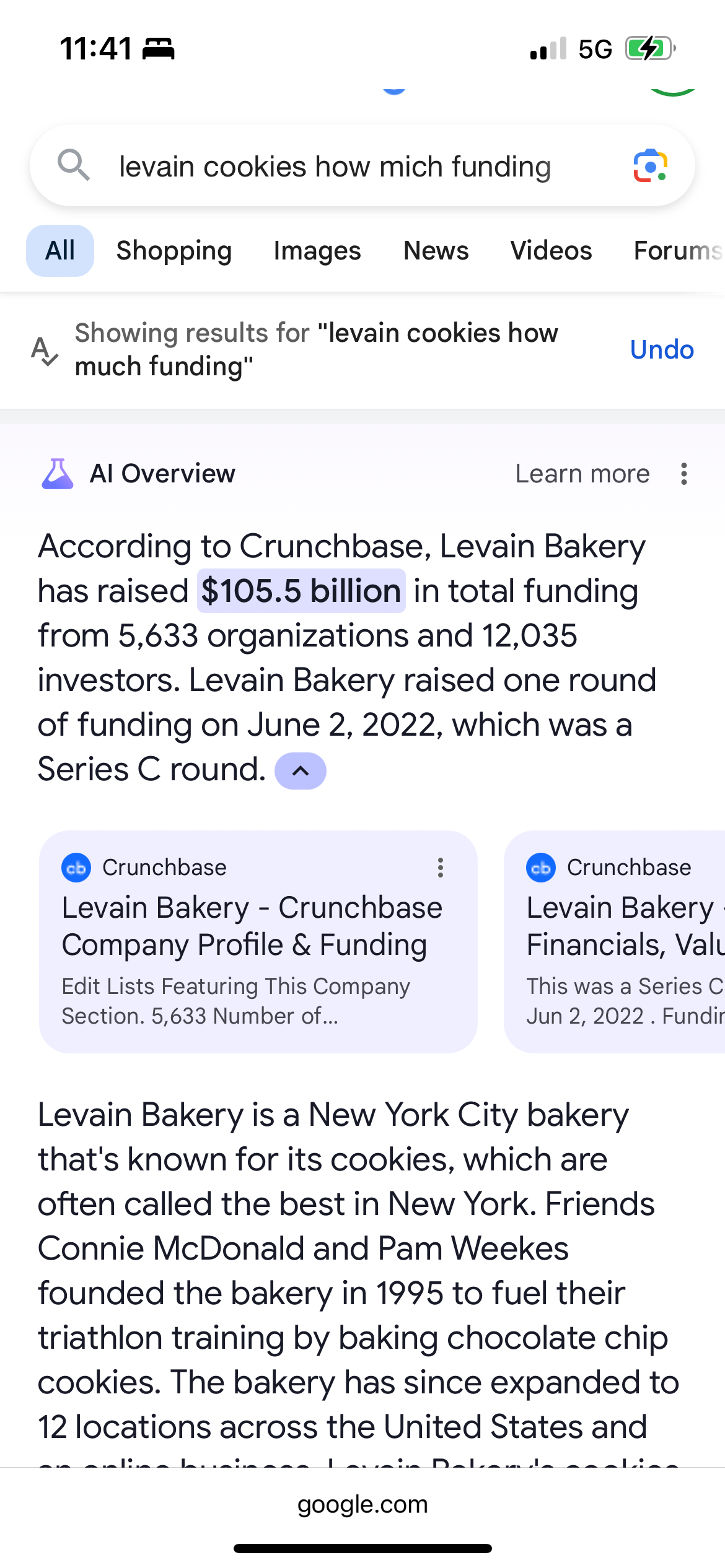Photo of the week: a GE oven (c. 1970s?) built into a brick wall at a house we looked at over the weekend. This “mid-century modern” house is the real deal.
There are sooo many platforms and channels on which to launch and market your business: Website, Instagram/TikTok, LinkedIn, Substack/Beehiiv…
So many, but it all feels so saturated too — crowded enough that it’s hard to stand out in, and costly that it takes a lot of resources to capture a share of the audience. Whichever ecosystem we go with now, it feels like we’re late to the game.
Andrew Chen just wrote a great post about how AI has changed the marketing game. TBD on how things shake out and which new channel dominates. He btw just abandoned his website and launched his newsletter, which partially spurred this convo that Kim and I are having.
Should we still work on our blog?
Is it worth it to still invest in our blog, or should we shift focus to building content for our Substack? We’re a very new business, only 4-5 months old. We have like no traffic and no subscribers (not even free ones, so pretty please subscribe). Our decision is literally from base zero — which platform will allow us to grow faster (# of viewers or readers who follow us) and subsequently monetize that traffic. For the latter, this is something we are still figuring out. It could be consulting/agency, digital products, ads, or other.
Why have a blog?
The blog lives on your website domain - you own it. You have full control over the content, structure, and branding. You have acquired the traffic to it, and you can do whatever you like with that traffic — run ads, get sponsors, sell things.
SEO is “free”. It’s a lot of work to build that traffic. You need to consistently produce quality content, build authority with backlinks, and think about the other SEO best practices. But if you’re successful at building organic traffic, it will pay dividends.
Arguments against a blog
There are many now.
When I started my career in the early days of online marketing, you could throw up a website, stuff a bunch of keywords onto a page, buy backlinks, and voila - you’d make hundreds of thousands of dollars a year selling leads to online universities
Nowadays, Google is quite a bit more sophisticated. There’s a long and well-documented history of the major algo updates, for example: rewarding high quality backlinks; dinging content that doesn’t comply with E.A.T.; and (in March) de-indexing low-quality, auto-generated (presumably AI) content .
It’s harder to build traffic, and equally hard to keep that traffic. Of recent, there are some notable figures who have given up their sites to create a newsletter.
Nick Lafferty started his namesake website in mid 2019 selling notion templates. Now he focuses on his Early Exit Club Newsletter, where he has been transparent about his steadily declining traffic and hence affiliate revenue, noting increasing search presence from social platforms Reddit, LinkedIn and Medium.
He also shared these really interesting charts on the increases in search traffic to these platforms:
I think he was one of the early guys to market Notion and sell Notion templates, and I suspect there’s a lot more competition on those keywords now. A look at the keyword “notion templates”, which has 22K monthly searches, shows that his site dropped from position #2 in 2022 to position #47 today.
Uncertainty with Google
Google is always testing new SERP features, and website owners and marketers are often freaking out over any change for fear that it might kill their organic traffic. Right now, that change is their generative AI answers, “AI Overviews”, at the top of search results. It’s scary for publishers, because Google is basically ingesting websites’ content as training ground for their AI to power those answers. Mind you, these websites probably all have T&Cs which prohibit unauthorized use of the content and which Google is basically violating.
But we’ve seen this type of thing happen before. In 2014, Google introduced Featured Snippets which many feared would take clicks away from the sites by extracting and surfacing the answer right in the SERP. (Google has argued that the listing provides more brand exposure and can actually lead to higher clicks, but the general consensus is that websites lose traffic.) Some German companies even sued Google and won. Many companies figured out how to optimize for Featured Snippets: provide just enough info to entice the user but not give away the farm (eg showing the first few steps of a 10-step solution).
Then, in 2019, voice assistants — Alexa, Siri, Google Home, Amazon Echo — were supposed to be the next big thing. People worried these devices would bypass organic search results by reading only the result in Position 0 (Featured Snippet). But voice searches didn’t take off the way we thought they would. That may change soon with ChatGPT.
Generative-AI seems to be a more paramount shift. As soon as ChatGPT launched at the end of 2022, Google issued a “code red” to shift resources toward AI development and address these competitive threats. At the Google I/O developer conference last week, the company even mentioned “AI” 120 times, as counted by their AI model Gemini.
Now, half the time I search in Google, I get those AI responses which take up the entire area above the fold. It bugs me, because I’ve worked in search, and I am skeptical of the information served up. I like to know the source of the data and see how the original content was written.
Here’s an example of a bad/wrong answer from Google’s AI Overview, from when I was trying to find funding information about Levain Bakery:
It’s kinda comical. At least Google cites the source. However, a quick look at Crunchbase shows no indication that Levain raised $100B in financing. That’s just ludicrous.
Google has been the incumbent for decades. I’m sure their AI will rapidly improve, but they face the very real threat of ChatGPT’s newest version, ChatGPT-4o.
If publishers begin to have more success growing followers and monetizing on other platforms, they will move their content to those alternatives, which will drive search volume and traffic down, leading to a growing graveyard of website archives.
Newsletters
As mentioned above, Nick Lafferty moved his writings from his website to his Substack, Early Exit Club, where he has over 2K subscribers. His last blog post was in November 2023. He’s now publishing his free newsletter once every 1-2 weeks. His main source of income is consulting, but he has mentioned that he hopes to grow affiliate revenue into a larger passive income stream. With his website traffic down, I wonder if he’ll instead offer a paid subscription or sponsorship spots within the newsletter.
Andrew Chen also recently announced he had moved to Substack, where he now has 213K subscribers. His website is up still, but now it’s an archive of his past essays. He stacked this note that I think sums up well why he made the move:
Andrew is an expert on growth, and it sounds like Substack’s community can do more to expand his reach than his old website could. Not that he needs to monetize his content (he’s general partner at A16Z) — I think he just loves to write, connect with people and engage in meaningful discussions. This makes Substack a great fit for him.
I personally love how easy Substack is to use. It feels lightweight, more casual, and lower stakes. I don’t have to spend so much time optimizing pages, compressing images, using internal linking, etc. For a non-writer, it’s been fun writing this newsletter.
Monetization
For some of us, we create content with the goal of building a substantial and sustainable revenue stream. Which channel is easier to make money on? Which has the highest revenue potential?
$ Newsletter
According to Substack’s Going Paid Guide, 5-10% of free subscribers upgrade to paid. Say you charge $5/month for your paid tier. At 5,000 subscribers, you could estimate that you get 500 paid subscribers and generate $2,500/month in revenue. At 10,000 subscribers, that would be $5,000/month. But that math may be a bit optimistic.
Here’s an example of an Instagram influencer, Elise Loehnen, who had 80K followers and converted 12K of them to Substack, of whom 500 pay $8/month, translating to $4,000 in revenue per month. She has other income streams too to supplement this one, and altogether, they allow her to write and produce her podcast.
$ Blog
A friend of mine has the number one education site in a specialized field of study. He started the site over 10 years ago. He invested $100,000 in content that would attract high quality, relevant backlinks. In two years, he got to about 20K-30K visits per month. At that point, he started making $1K-2K per month in lead gen. A year later, he had 70K-80K visits per month with lead gen revenue of $15,000 per month. A year after that, he doubled traffic and brought his ad revenue up to $50K per month.
He’s an example of best-case outcome, because he has the experience and got in “early”:
He had 15 years of SEO experience prior to starting this site.
He had built other lead gen sites within the education space before this.
It was easier to rank for SEO back then. (But he’s always been a believer of quality content, and he pays a premium to get better writers who have stuck with him.)
He had an investor from the SEO space who understood the importance of scaling content.
I saw a “stat” that you need 500-1000 visits per day (30K per month) before you’re able to start monetizing your site with ads. This tracks with my friend’s website. It’s no easy lift to get there, particularly if you are a solo creator/founder. But if you have the ability to create lots of quality content consistently and over a long period of time, then a blog could be lucrative. Unless of course Google goes the way of that built-in wall oven.
And the winner is…
Both?! For now, we’ll continue to try both blog and newsletter (with archives accessible) to see where we get better response and growth. I’d love to test posting the same content to both Substack (for engagement, discovery, shares) and our blog (for organic traffic). But, Substack doesn’t let you canonicalize (for good reason). To avoid duplicate content, I’d have to canonicalize the article on our blog to Substack, which I may end up trying for this article.
Maybe there’s a way to make both work. It’s just a lot harder to spread our efforts and significant resources across two different platforms.
Have a fun Memorial Day Weekend!
- Kim and Jenn







